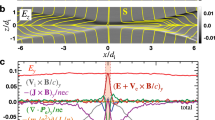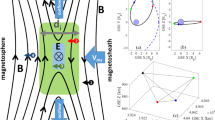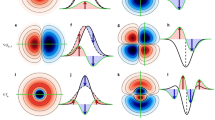Abstract
Magnetic reconnection in magnetized plasmas represents a change in magnetic field topology and is associated with a concomitant energization of charged particles that results from a conversion of magnetic energy into particle energy. In Earth’s magnetosphere this process is associated with the entry of the solar wind into the magnetosphere and with the initiation of auroral substorms. Using data from the THEMIS mission, together with global and test particle simulations, we demonstrate that electrons are energized in two distinct regions: a low-energy population (less than or equal to a few kiloelectronvolts) that arises in a diffusion region where particles are demagnetized and the magnetic topology changes, and a high-energy component (approaching 100 keV) that results from betatron acceleration within dipolarization fronts that sweep towards the inner magnetosphere far from the diffusion region. Thus, the observed particle energization is associated with both magnetic reconnection and with betatron acceleration associated with macroscopic flows.
This is a preview of subscription content, access via your institution
Access options
Subscribe to this journal
Receive 12 print issues and online access
$209.00 per year
only $17.42 per issue
Buy this article
- Purchase on Springer Link
- Instant access to full article PDF
Prices may be subject to local taxes which are calculated during checkout





Similar content being viewed by others
References
Sarris, E. T., Krimigis, S. M. & Armstrong, T. P. Observations of magnetospheric bursts of high-energy protons and electrons at approximately at 35 RE with Imp 7. J. Geophys. Res. 81, 2341–2355 (1976).
Kivelson, M. G. Summary remarks on the July 29, 1972 event. EOS 61, 335 (1980).
Baker, D. N. et al. Observation and modelling of energetic particles at synchronous orbit on July 29, 1977. J. Geophys. Res. 87, 5917–5932 (1982).
Sato, T., Matsumoto, H. & Nagai, K. Particle acceleration in time-developing magnetic reconnection process. J. Geophys. Res. 87, 6089–6097 (1982).
Åsnes, A. et al. Multispacecraft observation of electron beam in reconnection region. J. Geophys. Res. 113, A07S30 (2008).
Runov, A. et al. THEMIS observations of an earthward-propagating dipolarization front. Geophys. Res. Lett. 36, L14106 (2009).
Asano, Y. et al. Electron acceleration signatures in the magnetotail associated with substorms. J. Geophys. Res. 115, A05215 (2010).
Ashour-Abdalla, M. in Modern Challenges in Nonlinear Plasma Physics: A Festschrift Honoring the Career of Dennis Papadopoulos (eds Vassiliadis, D., Fung, S. F., Shao, X., Daglis, I. A. & Huba, J. D.) 196–207 (AIP Conf. Proc. 1320, American Institute of Physics, 2010).
Ashour-Abdalla, M., Bosqued, J. M., El-Alaoui, M., Peroomian, V. & Walker, R. Observations and simulations of a highly structured plasma sheet during northward IMF. J. Geophys. Res. 115, A10227 (2010).
Deng, X. et al. Wave and particle characteristics of earthward electron injections associated with dipolarization fronts. J. Geophys. Res. 115, A09225 (2010).
Øieroset, M., Lin, R. P., Phan, T. D., Larson, D. E. & Bale, S. D. Evidence for electron acceleration up to ∼300 keV in the magnetic reconnection diffusion region of Earth’s magnetotail. Phys. Rev. Lett. 89, 195001 (2002).
Pritchett, P. L. Relativistic electron production during driven magnetic reconnection. Geophys. Res. Lett. 33, L13104 (2006).
Pritchett, P. L. Relativistic electron production during guide field magnetic reconnection. J. Geophys. Res. 111, A10212 (2006).
Hoshino, M. Electron surfing acceleration in magnetic reconnection. J. Geophys. Res. 110, A10215 (2005).
Retinò, A. et al. Cluster observations of energetic electrons and electromagnetic fields within a reconnecting thin current sheet in the Earth’s magnetotail. J. Geophys. Res. 113, A12215 (2008).
Imada, S. et al. Energetic electron acceleration in the downstream reconnection outflow region. J. Geophys. Res. 112, A03202 (2007).
Birn, J. et al. Substorm electron injections: Geosynchronous observations and test particle simulations. J. Geophys. Res. 103, 9235–9248 (1998).
Zhou, M. et al. THEMIS observation of multiple dipolarization fronts and associated wave characteristics in the near-Earth magnetotail. Geophys. Res. Lett. 36, L20107 (2009).
Ambrosiano, J., Matthaeus, W. & Goldstein, M. Test-particle studies of acceleration by turbulent reconnection fields. J. Geophys. Res. 93, 14383–14400 (1988).
Hesse, M., Kuznetsova, M. & Hoshino, M. The structure of the dissipation region for component reconnection: Particle simulations. Geophys. Res. Lett. 29, 1563 (2002).
Pritchett, P. L. & Coroniti, F. V. Three-dimensional collisionless magnetic reconnection in the presence of a guide field. J. Geophys. Res. 109, A01220 (2004).
Drake, J. F., Swisdak, M., Che, H. & Shay, M. A. Electron acceleration from contracting magnetic islands during reconnection. Nature 443, 553–556 (2006).
Drake, J. F. et al. Formation of electron holes and particle energization during magnetic reconnection. Science 299, 873–877 (2003).
Drake, J. F., Shay, M. A., Thongthai, W. & Swisdak, M. Production of energetic electrons during magnetic reconnection. Phys. Rev. Lett. 94, 095001 (2005).
Kowal, G., Lazarian, A., Vishniac, E. T. & Otmianowska-Mazur, K. Numerical tests of fast reconnection in weakly stochastic magnetic fields. Astrophys. J. 700, 63–85 (2009).
Shinohara, I. et al. Low-frequency electromagnetic turbulence observed near the substorm onset site. J. Geophys. Res. 103, 20365–20388 (1998).
Hoshino, M., Mukai, T., Terasawa, T. & Shinohara, I. Superthermal electron acceleration in magnetic reconnection. J. Geophys. Res. 106, 25979–25978 (2001).
Auster, H. U. et al. The THEMIS fluxgate magnetometer. Space Sci. Rev. 141, 235–264 (2008).
Angelopoulos, V. The THEMIS mission. Space Sci. Rev. 141, 5–34 (2008).
McFadden, J. P. et al. THEMIS ESA first science results and performance issues. Space Sci. Rev. 141, 477–508 (2008).
Bonnell, J. W. et al. The electric field instrument (EFI) for THEMIS. Space Sci. Rev. 141, 303–341 (2008).
Le Contel, O. et al. First results of the THEMIS search coil magnetometers. Space Sci. Rev. 141, 509–534 (2008).
El-Alaoui, M. et al. Substorm evolution as revealed by THEMIS satellites and a global MHD simulation. J. Geophys. Res. 114, A08221 (2009).
Ashour-Abdalla, M., El-Alaoui, M., Coroniti, F. V., Walker, R. J. & Peroomian, V. A new convection state at substorm onset: Results from an MHD study. Geophys. Res. Lett. 20, 1965 (2002).
Ashour-Abdalla, M., Berchem, J. P., Büchner, J. & Zelenyi, L. M. Shaping of the magnetotail from the mantle—Global and local structuring. J. Geophys. Res. 98, 5651–5676 (1993).
Schriver, D., Ashour-Abdalla, M. & Richard, R. L. On the origin of the ion-electron temperature difference in the plasma sheet. J. Geophys. Res. 103, 14879–14896 (1998).
Schriver, D. et al. in Proceedings of the 7th ISSS 345–346 (Research Institute for Sustainable Humanosphere (RISH), Kyoto University, 2005).
Büchner, J. & Zelenyi, L. M. Chaotization of the electron motion as the cause of an internal magnetotail instability and substorm onset. J. Geophys. Res. 92, 13456–13466 (1987).
Büchner, J. & Zelenyi, L. M. Regular and chaotic charged particle motion in magnetotaillike field reversals. I—Basic theory of trapped motion. J. Geophys. Res. 94, 11821–11842 (1989).
Acknowledgements
We thank H. Kohne for help with programming and display of the data and simulation results. Research at UCLA was supported by NASA grant NNX08AO48G. We acknowledge NASA contract NAS5-02099 and V. Angelopoulos for use of data from the THEMIS Mission, specifically, C. W. Carlson and J. P. McFadden for the use of ESA data, D. Larson and R. P. Lin for the use of SST data, K. H. Glassmeier, U. Auster and W. Baumjohann for the use of FGM data, J. W. Bonnell and F. S. Mozer for the use of EFI data, and A. Roux and O. LeContel for the use of SCM data. K-J.H. and M.L.G. were supported, in part, by NASA’s Magnetospheric Multiscale and Cluster missions at the Goddard Space Flight Center. M.G.K. was supported, in part, by NASA Grant UCB NAS 5-02099. The computing was carried out on NASA’s Columbia Supercomputer.
Author information
Authors and Affiliations
Contributions
M.A-A. initiated the electron acceleration study using observations and simulations. She led the research project, participated in the analysis of all of the simulation and observation results. M.E-A. carried out the MHD simulations and identified the dipolarization fronts in the Global model. He also participated in the analysis. M.G. was the first to realize the importance of this study. From his experience of Cluster data, he realized the wide applicability of these results. M.Z. carried out the particle simulations and participated in the analysis of the particle results. D.S. participated in the analysis of the particle results. R.R. developed the algorithm for converting simulation counting rates into differential energy flux and carried out the betatron acceleration analysis. R.W. participated in the analysis of the simulation results with emphasis on the MHD results. M.G.K. helped with theoretical issues; in particular she suggested analysis to quantify the betatron acceleration. K-J.H. applied experience she gained from studying electron acceleration during other dipolarization events seen by Cluster.
Corresponding author
Ethics declarations
Competing interests
The authors declare no competing financial interests.
Supplementary information
Supplementary Information
Supplementary Information (PDF 277 kb)
Rights and permissions
About this article
Cite this article
Ashour-Abdalla, M., El-Alaoui, M., Goldstein, M. et al. Observations and simulations of non-local acceleration of electrons in magnetotail magnetic reconnection events. Nature Phys 7, 360–365 (2011). https://doi.org/10.1038/nphys1903
Received:
Accepted:
Published:
Issue Date:
DOI: https://doi.org/10.1038/nphys1903
This article is cited by
-
Particle Acceleration by Magnetic Reconnection in Geospace
Space Science Reviews (2023)
-
Kinetic properties of collisionless magnetic reconnection in space plasma: in situ observations
Reviews of Modern Plasma Physics (2022)
-
Particle energization in space plasmas: towards a multi-point, multi-scale plasma observatory
Experimental Astronomy (2022)
-
Magnetotail dipolarization fronts and particle acceleration: A review
Science China Earth Sciences (2020)
-
Electron Power-Law Spectra in Solar and Space Plasmas
Space Science Reviews (2018)



